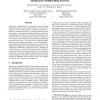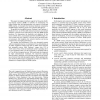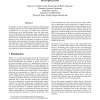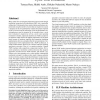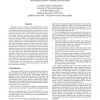ISCA
1996
IEEE
14 years 7 months ago
1996
IEEE
Parallel workstations, each comprising 10-100 processors, promise cost-effective general-purpose multiprocessing. This paper explores the coupling of such small- to medium-scale s...
ISCA
1996
IEEE
14 years 7 months ago
1996
IEEE
Simultaneous multithreading is a technique that permits multiple independent threads to issue multiple instructions each cycle. In previous work we demonstrated the performance po...
ISCA
1996
IEEE
14 years 7 months ago
1996
IEEE
Current high performance computer systems use complex, large superscalar CPUs that interface to the main memory through a hierarchy of caches and interconnect systems. These CPU-c...
ISCA
1996
IEEE
14 years 7 months ago
1996
IEEE
This paper investigates hardware support for fine-grain distributed shared memory (DSM) in networks of workstations. To reduce design time and implementation cost relative to dedi...
ISCA
1996
IEEE
14 years 7 months ago
1996
IEEE
In the future, advanced integrated circuit processing and packaging technology will allow for several design options for multiprocessor microprocessors. In this paper we consider ...
ISCA
1996
IEEE
14 years 7 months ago
1996
IEEE
Historically, processor accesses to memory-mapped device registers have been marked uncachable to insure their visibility to the device. The ubiquity of snooping cache coherence, ...
ISCA
1996
IEEE
14 years 7 months ago
1996
IEEE
Memory latency is an important bottleneck in system performance that cannot be adequately solved by hardware alone. Several promising software techniques have been shown to addres...
ISCA
1996
IEEE
14 years 7 months ago
1996
IEEE
Many studies have investigated performance improvement through exploiting instruction-level parallelism (ILP) with a particular architecture. Unfortunately, these studies indicate...
ISCA
1996
IEEE
14 years 7 months ago
1996
IEEE
This paper makes the case that pin bandwidth will be a critical consideration for future microprocessors. We show that many of the techniques used to tolerate growing memory laten...
ISCA
1996
IEEE
14 years 7 months ago
1996
IEEE
In an effort to push the envelope of system performance, microprocessor designs are continually exploiting higher levels of instruction-level parallelism, resulting in increasing ...

